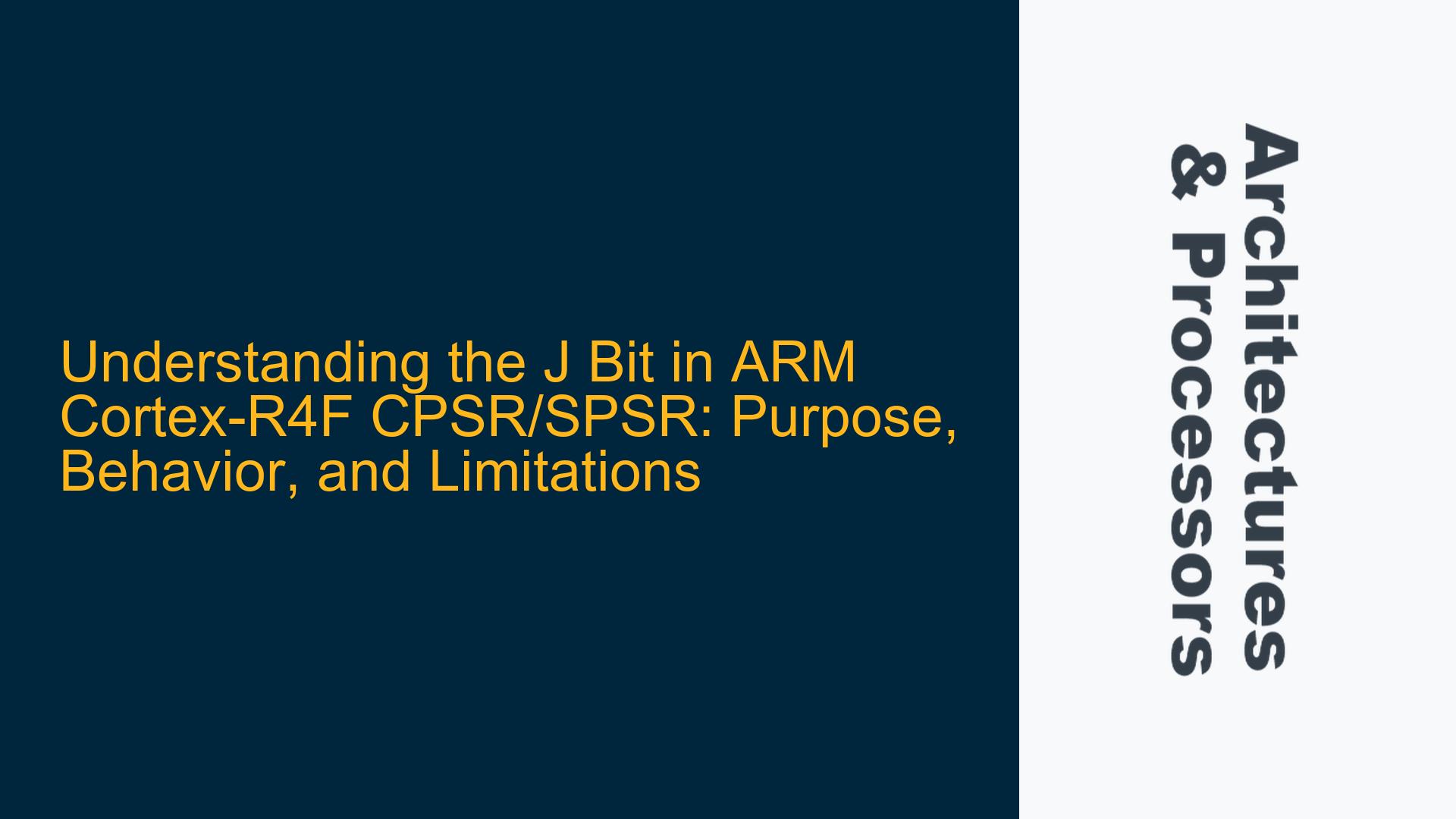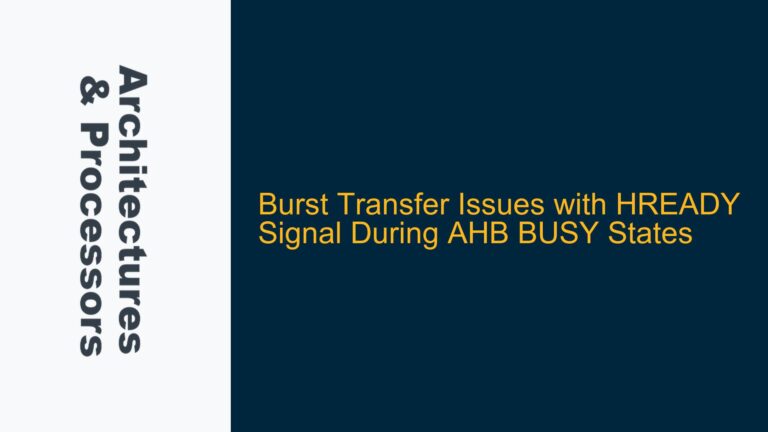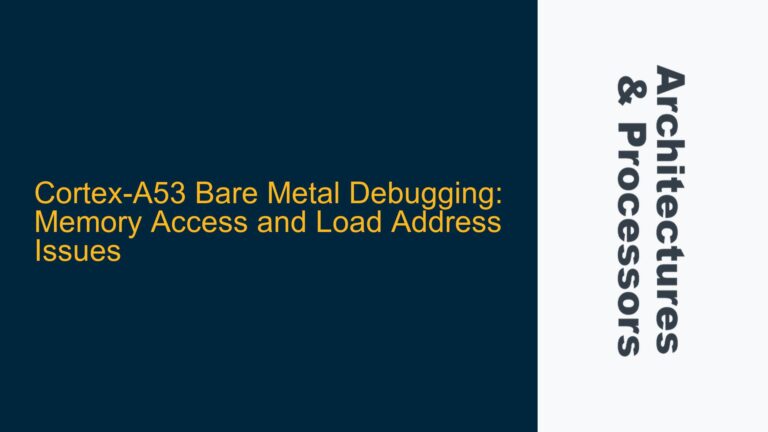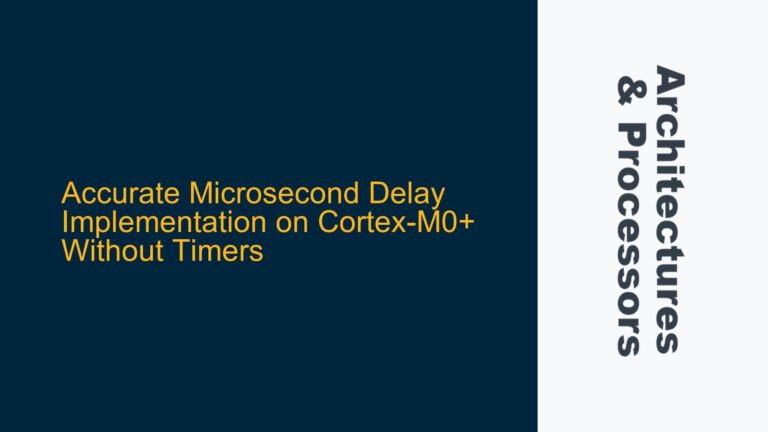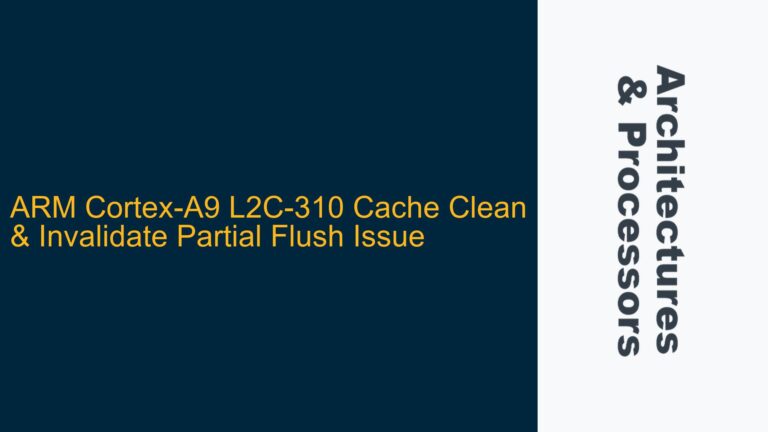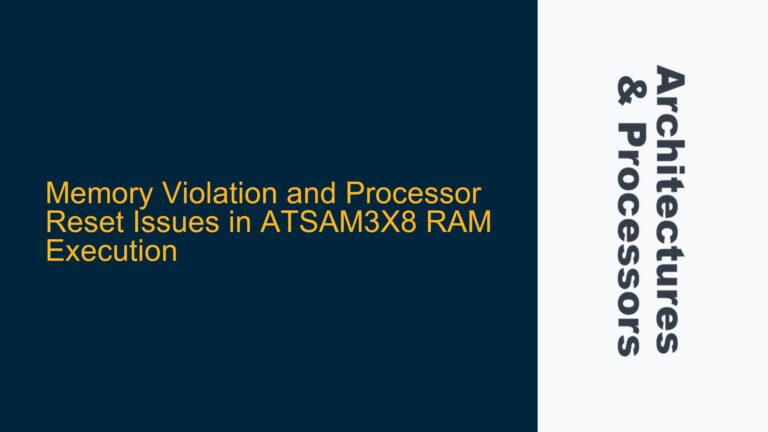ARM Cortex-R4F CPSR/SPSR J Bit: Purpose and Behavior
The J bit in the Current Program Status Register (CPSR) and Saved Program Status Register (SPSR) of the ARM Cortex-R4F processor is a single-bit field that plays a specific role in the processor’s operation. The CPSR and SPSR are critical components of the ARM architecture, as they store the processor’s current state, including flags, interrupt masks, and execution mode. The J bit, in particular, is associated with the processor’s execution state and its support for the Jazelle instruction set.
The J bit is located at bit 24 of the CPSR/SPSR. Its primary purpose is to indicate whether the processor is operating in Jazelle state, which is a unique execution mode designed to accelerate Java bytecode execution. When the J bit is set to 1, the processor is in Jazelle state, and when it is set to 0, the processor is in ARM or Thumb state. However, in the case of the ARM Cortex-R4F, the J bit is hardwired to read as 0, meaning that the processor does not support the Jazelle instruction set.
The Jazelle instruction set was introduced by ARM to improve the performance of Java applications on embedded systems. It allows the processor to execute Java bytecode directly, without the need for interpretation or Just-In-Time (JIT) compilation. However, Jazelle support is not universal across all ARM processors. In the case of the Cortex-R4F, which is designed for real-time and safety-critical applications, Jazelle support is not included. This is why the J bit is hardwired to 0 and cannot be modified.
The behavior of the J bit in the Cortex-R4F is consistent with the ARMv7-R architecture, which the Cortex-R4F implements. According to the ARMv7-R reference manual, the J bit is read-only and always returns 0. This is because the Cortex-R4F does not include the hardware necessary to support Jazelle execution. Attempting to write to the J bit using the MSR (Move to Status Register) instruction will have no effect, as the bit is not writable.
In summary, the J bit in the Cortex-R4F CPSR/SPSR serves as an indicator of Jazelle support, but in this specific processor, it is hardwired to 0, reflecting the lack of Jazelle support. This behavior is consistent with the ARMv7-R architecture and is documented in the processor’s reference manual.
Why the J Bit is Hardwired to 0 in Cortex-R4F: Architectural and Design Considerations
The J bit being hardwired to 0 in the ARM Cortex-R4F is not an arbitrary design choice but rather a result of several architectural and design considerations. Understanding these considerations requires a deeper dive into the Cortex-R4F’s target applications, the role of the Jazelle instruction set, and the trade-offs involved in implementing such features.
The Cortex-R4F is part of ARM’s Cortex-R series, which is specifically designed for real-time and safety-critical applications. These applications often require deterministic behavior, low latency, and high reliability. Examples include automotive systems, industrial control systems, and medical devices. In such environments, the primary focus is on real-time performance and fault tolerance, rather than on executing high-level languages like Java.
The Jazelle instruction set, while beneficial for Java execution, introduces additional complexity to the processor’s design. Implementing Jazelle requires dedicated hardware to decode and execute Java bytecode, which increases the processor’s gate count and power consumption. For the Cortex-R4F, which is optimized for real-time performance and low power consumption, the additional overhead of Jazelle support is not justified. This is especially true given that Java is not commonly used in the types of applications the Cortex-R4F is designed for.
Furthermore, the Jazelle instruction set is more relevant to application processors, such as those found in smartphones and tablets, where Java execution is a common requirement. In contrast, the Cortex-R4F is typically used in embedded systems where the software stack is often written in C or assembly language, and real-time operating systems (RTOS) are commonly employed. In these environments, the need for Java execution is minimal, and the inclusion of Jazelle support would not provide significant benefits.
Another consideration is the complexity of the Jazelle state itself. When the J bit is set to 1, the processor enters Jazelle state, which is a distinct execution mode with its own set of rules and behaviors. This adds complexity to the processor’s state management and can complicate debugging and verification processes. For a processor like the Cortex-R4F, which is often used in safety-critical systems, minimizing complexity is a key design goal. By hardwiring the J bit to 0, the Cortex-R4F avoids the additional complexity associated with Jazelle state, simplifying the processor’s design and making it easier to verify and validate.
Finally, the decision to hardwire the J bit to 0 is consistent with the ARMv7-R architecture, which the Cortex-R4F implements. The ARMv7-R architecture is designed for real-time applications and does not include support for Jazelle. This is in contrast to the ARMv7-A architecture, which is used in application processors and does support Jazelle. By adhering to the ARMv7-R architecture, the Cortex-R4F ensures compatibility with other processors in the Cortex-R series and maintains a consistent architectural approach across its target applications.
In summary, the J bit is hardwired to 0 in the Cortex-R4F due to a combination of factors, including the processor’s target applications, the lack of need for Java execution, the desire to minimize complexity, and adherence to the ARMv7-R architecture. These considerations reflect the Cortex-R4F’s focus on real-time performance, low power consumption, and reliability, making it well-suited for its intended use cases.
Implications of the J Bit Being Hardwired to 0: Debugging, Software Development, and System Design
The fact that the J bit is hardwired to 0 in the ARM Cortex-R4F has several implications for debugging, software development, and system design. Understanding these implications is crucial for developers working with the Cortex-R4F, as it affects how they approach tasks such as debugging, writing low-level software, and designing systems that use the processor.
One of the primary implications is that developers do not need to account for Jazelle state when writing software for the Cortex-R4F. Since the J bit is hardwired to 0, the processor will never enter Jazelle state, and there is no need to include code to handle Jazelle-specific behaviors. This simplifies the software development process, as developers can focus on writing code for the ARM and Thumb execution states without worrying about the additional complexity of Jazelle.
However, this also means that developers cannot use Jazelle to accelerate Java execution on the Cortex-R4F. If Java execution is required, developers will need to use alternative approaches, such as interpretation or Just-In-Time (JIT) compilation. These approaches may introduce additional overhead and complexity, but they are necessary given the lack of Jazelle support in the Cortex-R4F.
From a debugging perspective, the hardwired J bit simplifies the process of analyzing the processor’s state. Since the J bit is always 0, developers do not need to consider the possibility of the processor being in Jazelle state when examining the CPSR or SPSR. This reduces the number of potential states the processor can be in, making it easier to diagnose issues and understand the processor’s behavior during debugging.
In terms of system design, the hardwired J bit means that the Cortex-R4F is not suitable for applications that require Jazelle support. If Jazelle is a requirement, developers will need to consider using a different processor, such as one from the Cortex-A series, which does support Jazelle. However, for applications that do not require Jazelle, the Cortex-R4F’s focus on real-time performance and low power consumption makes it an excellent choice.
Another implication is that developers should be aware of the limitations of the Cortex-R4F when designing systems that may need to support Java in the future. While the Cortex-R4F may be suitable for current requirements, future needs may necessitate the use of a processor with Jazelle support. In such cases, developers should consider the long-term requirements of their systems and plan accordingly.
Finally, the hardwired J bit highlights the importance of understanding the specific features and limitations of the processor being used. While the Cortex-R4F is a powerful and versatile processor, it is not a one-size-fits-all solution. Developers should carefully evaluate their requirements and choose a processor that aligns with their needs, taking into account factors such as real-time performance, power consumption, and support for specific instruction sets like Jazelle.
In summary, the J bit being hardwired to 0 in the Cortex-R4F has several implications for debugging, software development, and system design. It simplifies software development and debugging by eliminating the need to account for Jazelle state, but it also means that Java execution cannot be accelerated using Jazelle. Developers should be aware of these implications when designing systems and choosing processors, ensuring that their choices align with their requirements and long-term goals.
Conclusion
The J bit in the ARM Cortex-R4F CPSR/SPSR is a read-only bit that is hardwired to 0, reflecting the processor’s lack of support for the Jazelle instruction set. This design choice is consistent with the Cortex-R4F’s focus on real-time performance, low power consumption, and reliability, making it well-suited for safety-critical and real-time applications. While the hardwired J bit simplifies software development and debugging, it also means that developers cannot use Jazelle to accelerate Java execution on the Cortex-R4F. Understanding the purpose, behavior, and implications of the J bit is crucial for developers working with the Cortex-R4F, as it affects how they approach tasks such as debugging, writing low-level software, and designing systems. By carefully considering the Cortex-R4F’s features and limitations, developers can make informed decisions that align with their requirements and ensure the success of their projects.
